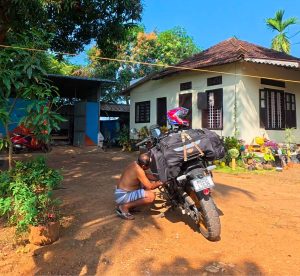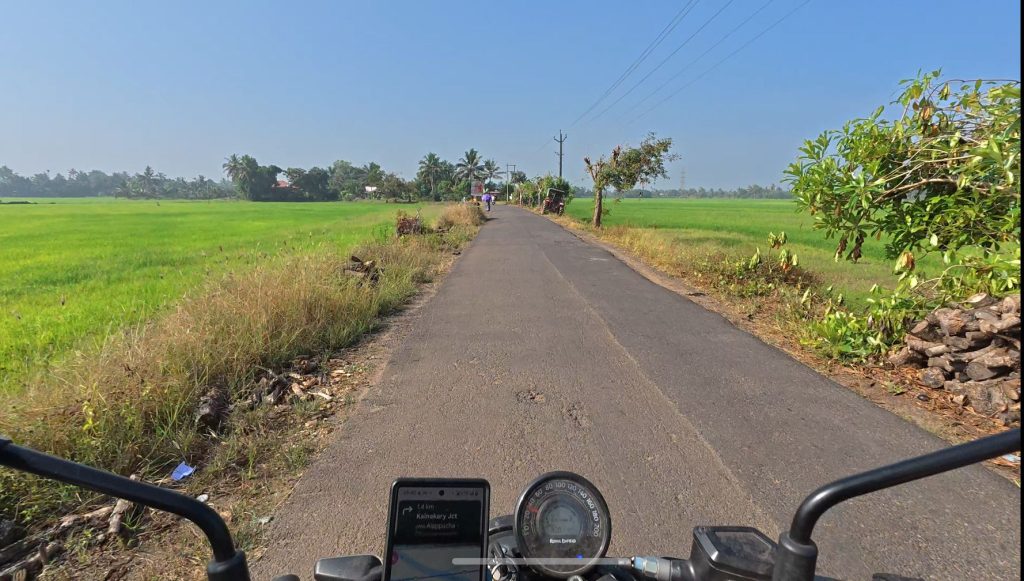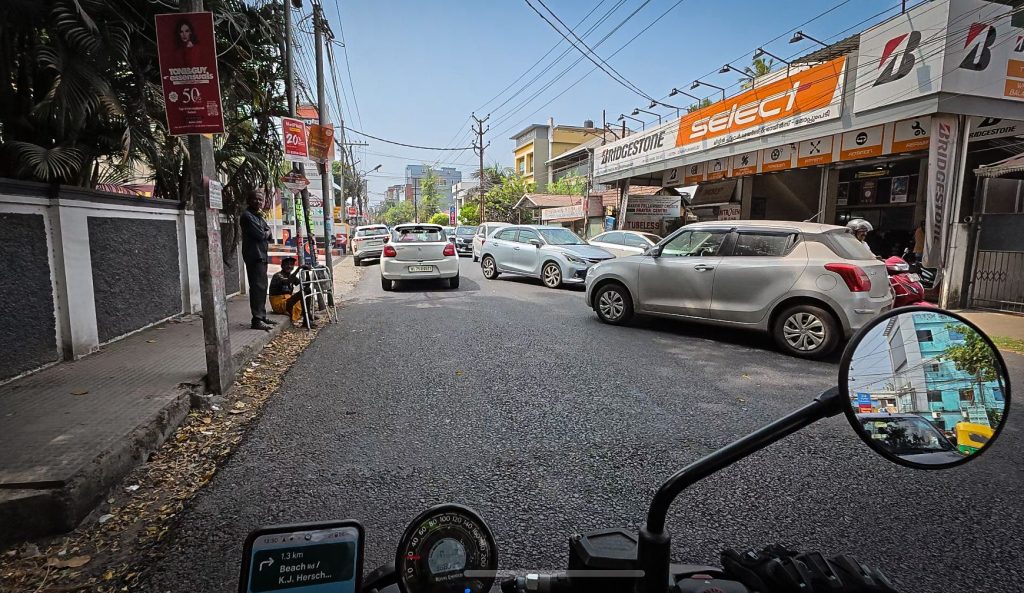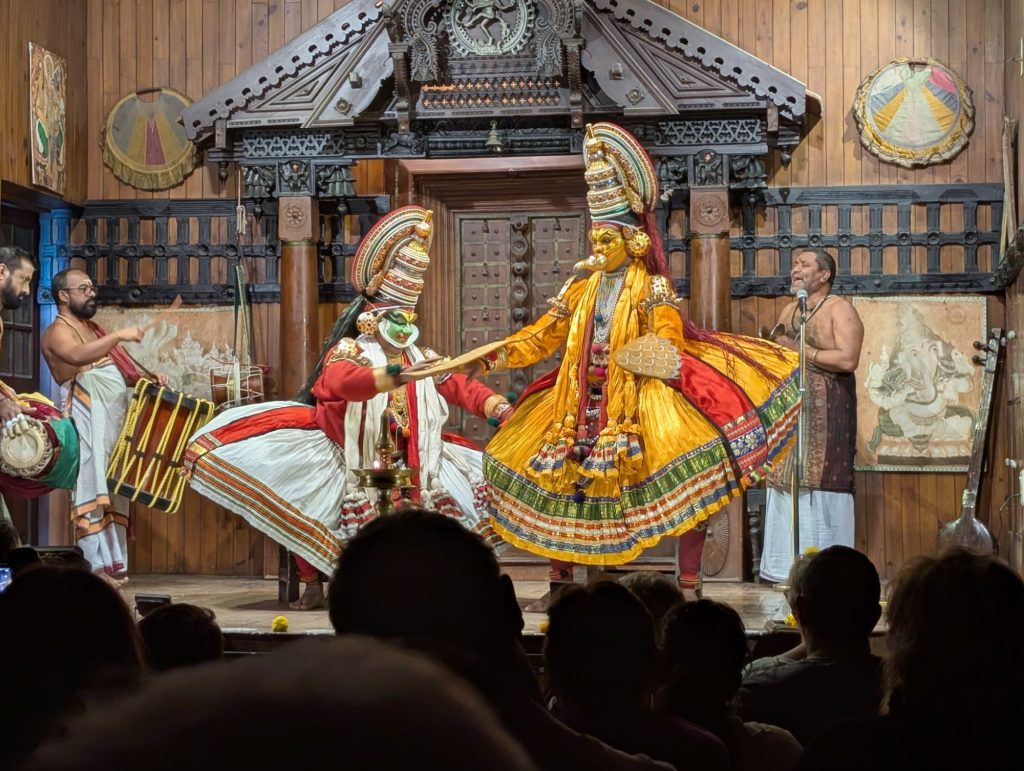Lessons in Comfort and Chaos: A Ride to Fort Kochi
The day started with hope. Our bikes were waiting for us where we’d parked them, safe and sound for the modest price of 50 rupees. My horn still wasn’t working, a vital piece of equipment in Indian traffic.
On the way to the Royal Enfield dealership, we spotted a small roadside mechanic and decided to give it a shot. Within minutes, he had my horn back in action and even straightened Dalma’s bent brake lever from her earlier fall at Dhinbam Ghat using a sledgehammer (to wedge between the brake lever and handlebar) and a pipe (to bend the lever). The whole thing cost just 100 rupees, about $2 AUD.

It didn’t last—my horn went silent again later—but the effort and ingenuity of the mechanic were impressive. For now, I had to stick with rev bombing the engine to make my presence known.

Leaving our mechanic, we faced a choice: follow Google Maps onto the ever-frustrating NH66 or stick to the backroads. We opted for the latter, stitching together routes from Google and OSMAnd. It was the right call in theory, but the roads proved almost as chaotic as the highway.
Small, winding lanes threaded through villages and towns, clogged with Saturday traffic. The heat was relentless, and without enough speed to cool our phones or ourselves, everything overheated—our devices, our tempers, and our patience. Progress was painfully slow, averaging 35 km/h, with every rare stretch of 40 km/h feeling like a victory lap.

Despite the struggle, the backroads offered glimpses of Kerala’s everyday life—vendors shouting their wares while wheeling carts, children playing barefoot by the roadside, and the occasional temple procession spilling onto the street. It was chaotic, yes, but undeniably vibrant.
By early afternoon, we arrived in Fort Kochi, the historic heart of the city. We’d booked a guesthouse in the old town, charmed by its reviews and proximity to the sights. It didn’t take long to realize we’d made a mistake.
The old buildings, while picturesque, were never designed for modern comforts. The guesthouse, marketed as a “homestay,” was clean but sparse—no blankets, basic amenities, and barely functional service. Parking for our motorcycles was an afterthought, crammed into a tiny corner of the property.
What’s more, Fort Kochi itself felt overwhelmingly touristy. The streets were lined with quirky, artsy shops and cafés catering to Western visitors, but the charm was dulled by the sheer volume of people and the transactional nature of it all. We’ve traveled enough to know that tourist hubs often lose the very authenticity that draws people to them, and this was no exception.
Dinner that evening reinforced our growing disappointment. We found a restaurant that looked promising—attractive décor, decent menu—but the service was indifferent to the point of frustration. Requests for simple things, like water or the bill, were ignored repeatedly. After asking for the bill five times, we finally resorted to walking out just to get someone’s attention.
This kind of indifference wasn’t India, where even the simplest accommodations came with warm, attentive hosts. Here, in the heart of a tourist hotspot, the care seemed to have evaporated.
By the end of the day, we agreed on one thing: staying in old, historic areas comes with a trade-off. If you want modern comforts—spacious rooms, good service, secure parking—you’ll have to stay outside the tourist bubble and commute in for sightseeing. If you want the charm of staying in the heart of the history, you’ll have to accept the quirks and limitations that come with it.
For now, we’ll spend another night here, but for our final day in Kochi, we’ll move to a hotel near the train station. It’s practical, closer to our next departure point, and hopefully less frustrating.
Today wasn’t easy, but the road offered its own lessons. The backroads reminded us why we ride—not for speed, but for the small, unplanned moments: the mechanic who patched up our bikes with care, the glimpses of daily life that flash by on winding roads, and the challenge of navigating a culture so different from our own.
As visitors, it’s not our place to judge, but rather to observe, adapt, and learn. And while Fort Kochi wasn’t quite what we hoped for, it’s another piece of the puzzle that makes this journey what it is: unpredictable, imperfect, and utterly unforgettable.
